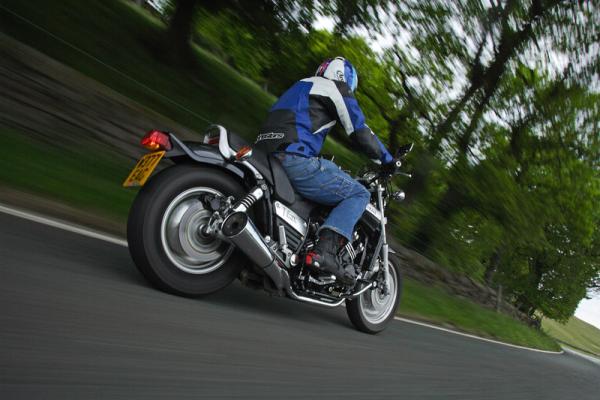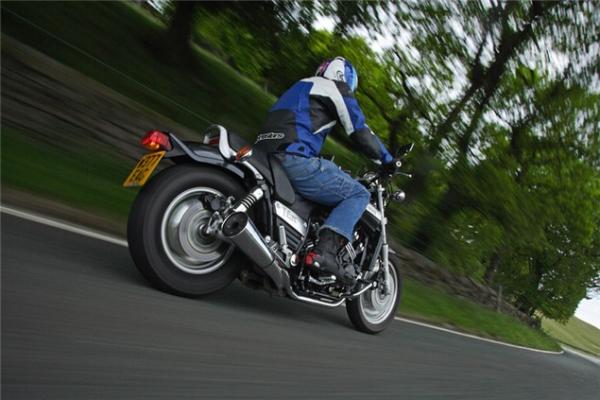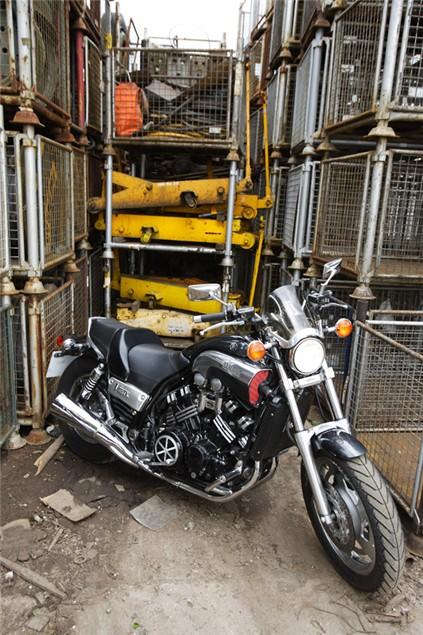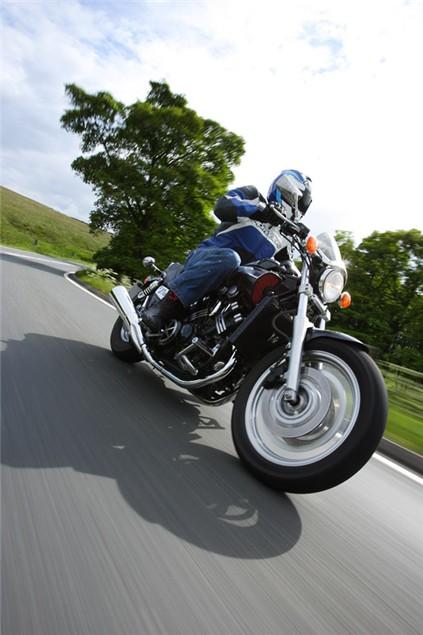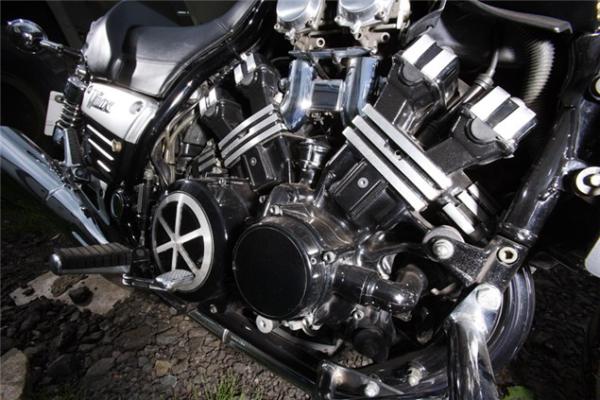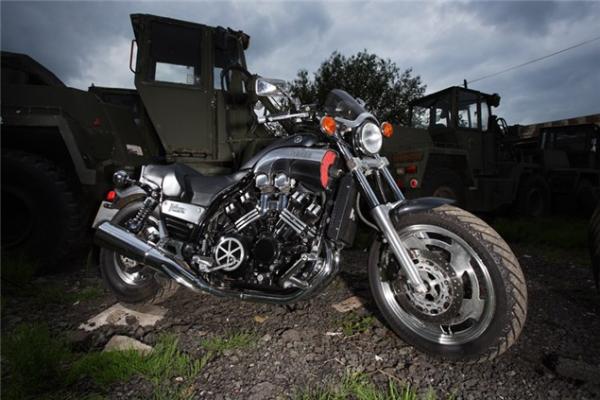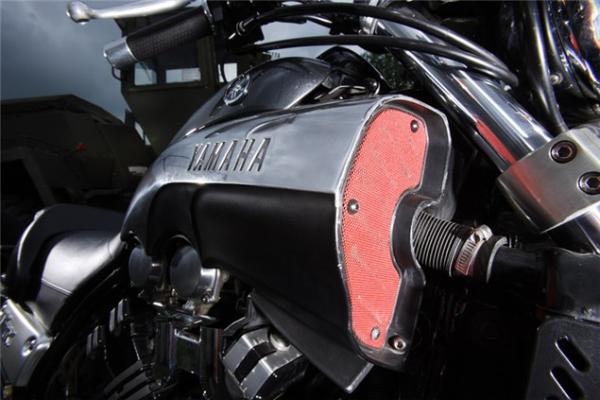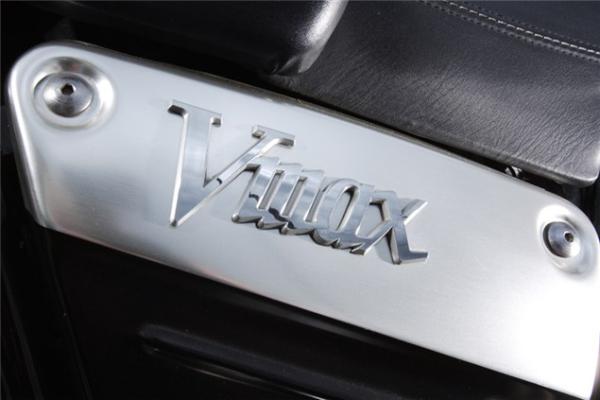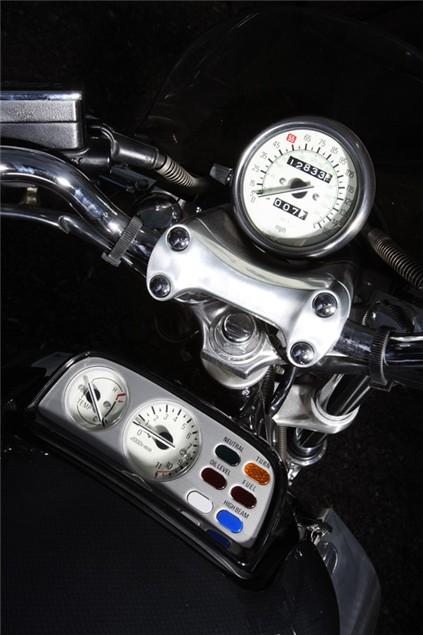Japanese Muscle: Yamaha Vmax used review
In 1985 Yamaha launched an unashamed brute of a bike. Born on the drag strip the V-Max was a mass of metal and chrome which instantly drew a cult following. Now, 23 years on, does the old master still command any respect?

Member for
54 years 8 monthsClick to read: Yamaha Vmax owners reviews, Yamaha Vmax specs and to see the Yamaha Vmax image gallery.
“It’s like a 140bhp shopping trolley, totally lethal, have a good time.” These were the parting words from the DK salesman as he handed over the Vmax’s key, not exactly words that instilled me with confidence. But there again, this is a 23-year-old bike, how nasty could it really be? About three hours later I was heading for a hedge, eyes as big as saucers, while below me the Vmax wobbled and weaved as the chassis attempted to untie itself from the knot its suspension had wound itself into.
I was only eight when the original Vmax was launched, so I missed out on all the hype surrounding it. At the time I was more concerned about the imminent unveiling of an Optimus Prime Transformer than a 145bhp muscle bike. Over the subsequent years the name has come up in conversation, but because it’s no longer made I’ve never found a reason to ride one. But, with the arrival of Yamaha’s new Vmax, now seemed like the perfect excuse.
Usually with second hand bikes, especially ones this old, getting your hands on a good condition used model is a nightmare. Not so with the Vmax. A call to DK Motorcycles in Stoke and sales manager Garry Mackay surprised me by saying he had just registered a brand new Vmax on a 2008 plate and had some excellent second hand examples. Despite the bike being discontinued in Europe in 2004, the US market kept demanding Yamaha make the bike right up until 2007, so brand new examples are still available on import. But at what cost? A brand new one will set you back £7,199 while the bike I was set to ride, a 2000 model, would be closer to £5,000. That’s not that far off its retail price of £7,239. How come?
“My three best-selling second hand bikes are Hayabusa, R6 and Vmax,” Garry told me, “If I could get 10 new Vmaxs in tomorrow I’d sell them all by next week. They have a huge cult following.”
Wheeling the bike out of the showroom and into the sunlight I got my first chance to really poke around a Vmax. It’s still a good-looking bike, mean and aggressive with the huge engine dominating its style. The monstrous, yet somehow only 1198cc, V4 is styled for show with the whole motor painted black then polished to a mirror finish on a the edges of the engine fins, cam covers and cases to create the look. Contrast is the key to the Vmax’s style. If it isn’t black it’s polished chrome, accentuating the bike’s features and lines. Which is why I assumed that the fake carbon petrol tank cover and rear mudguard on this model were aftermarket additions. Not so, late in its life Yamaha actually produced the bike with this slightly tacky look. But this is a bike from a different age, in the late ‘90s carbon-effect was all the rage.
Turning the key in the ignition the Vmax whirrs from deep inside. If you have ridden any Yamaha with a YPVS sticker on it you will know this sound. It’s the sound of power valves priming. Early European bikes never made this noise as, bizarrely, Yamaha Europe took the decision not to enable the V-Boost system until 1996, neutering the bike to 95bhp rather than the claimed boost-assisted 145bhp. The bikes were easily modified, but this short-sightedness by Yamaha Europe spawned a huge influx of US import bikes and second hand V-Boost kits in to Britain. A story that echoes most of the Vmax’s life in the UK. It took six years from its original launch in 1985 until the Vmax went on official sale in the UK, and a further five until it was full power. But staggeringly the bike still sold. Imagine trying to punt off an 11 year-old FireBlade today, you wouldn’t stand a chance. But the Vmax is no ordinary bike.
V-BOOST TECHNOLOGY
The Vmax has four carbs, one for each cylinder. The problem is that they are very small, which is better for low down power, not high rpm. Below 6,000rpm they feed each cylinder as normal, but at 6,000rpm things change. A solenoid moves a butterfly flap that effectively links up the pairs of carbs. So, rather than be fed fuel and air by one carb, each cylinder is fed by two, effectively doubling (well, actually a bit less) the amount of fuel dumped into the motor. More fuel equals more power. Simple.
Initially I was genuinely a bit nervous riding the Yamaha. I’ve heard all the stories and imagined that the Vmax would be some drag-strip demon, trying to rip my arms off at the slightest whiff of throttle while refusing to corner unless forced to do so. After about a mile I was beginning to wonder what all the fuss was about. It’s a great big pussycat.
Through the city streets the Vmax was totally refined, calm and very pleasant to ride. The V4 engine makes a lovely deep purring sound while the seating position, which initially feels odd with its highish pegs and short reach to the bars, isn’t too uncomfortable. Hell, even the clutch is light. Fair play, even at slow speeds you can feel how terrible the brakes are, impressively managing to combine a total lack of feel with a uniform lack of stopping power.
Heading out of town I settle into a steady 50mph cruise, soaking up the Vmax feeling. Its whole persona as a mean and moody bike starts to rub off on you as a rider and you feel tough riding it, especially when there are people watching. Despite its age the Vmax still turns heads, even non-bikers appreciate its style. There is something basic about it with its metal and moving parts brazenly exposed to the world, not hidden apologetically by a fairing.
Having cleared the city limits I’m stopped by a set of traffic lights. Revving up the Vmax I decide to test its straight line speed when the green light shows. First goes into second, then third and we’re at 80mph. It’s not mind-blowing by modern bike standards but the Vmax still hitches up its skirt and goes. Considering this is an engine made over 20 years ago it’s bloody impressive and while it might not top the likes of a modern GSX-R1000 it wouldn’t be far off up to about 80mph. You have to remember that when the Vmax was launched the sportsbikes were Suzuki’s GSX-R1100, which claimed 128bhp, and Kawasaki’s RX1000, which claimed 125bhp. Imagine hearing about a 145bhp performance bike with a V4 engine and you can see why people were clambering to get hold of this fire-breathing beast from over the pond.
Everyone I spoke to beforehand was enthusing about the kick at 6,000rpm when the V-Boost system comes in, so I was expecting a gigantic whoosh of power, which didn’t really arrive. Sure there is a boot, but it’s nothing like the two-stroke kick that some owners were talking about. Hit the sweet spot and it goes, but the bike is so torque-laden before this point it just feels like it is pulling even harder, I suppose riders in 1985 were used to power trailing off up the rev range, not getting even stronger. Considering it was developed in the 1980s it’s amazingly strong. Unfortunately the chassis isn’t as impressive.
You don’t corner at speed on a Vmax, you aim it in vagely the right direction, wait for the chronic wobble to subside then pray you make it around the bend. I think Garry was doing it a favour describing it as a shopping trolley, it’s far, far worse. Cutting across the Peak District on the Yamaha I thought on number of occasions I was going to wobble straight off the road and end up as part of the scenery. The suspension is terrible and even the pathetic front brake is enough to bottom out the matchstick thin forks should you hit a bump while they are applied. It’s a terrifying experience and not one I wish to repeat any time soon. Even though the whole rollercoaster happens below 80mph I can’t think of any bike I’ve ridden that is more out of control. And the one I rode was the updated Vmax with ‘beefy’ 43mm forks, the original had 40mm ones!
Having survived the Peak District I was about 10 miles from DK’s showroom when it started to drizzle with rain. Pulling away from a set of traffic light the engine sounded a bit funny, changing into second the sound continued and just as I was thinking the clutch must be slipping the whole bike slewed sideways before the rear tyre gripped and started the bike into another wobble. I wasn’t even accelerating hard but the torque was enough to break the rear tyres traction. In the dry at gentle speeds I was lulled into thinking this bike was a pussycat, but up the speed or throw in a bit of rain and it’s an animal and I was more than relieved to return it in one piece.
Having spent a day on the Vmax I can see where it gained its reputation. Like so many cult bikes the Vmax has one outstanding feature, while the rest requires serious work to get it to function properly. This is the challenge to owners and one they happily take on, and so the cult begins as specialist shops spring up supplying the demand. 23 years on the Vmax still has a terrific engine that wouldn’t feel that out of place if it was launched today, the chassis on the other hand does need some work. But I guess that’s all part of its appeal.
Customising & Tuning the Max
Customising the Max
Henry Doyle has run specialist Vmax accessories firm Exactrep For the last 15 years. Exactrep has been the first stop for Vmax owners wanting to customise their bike.
“The Vmax was a bike that was born a legend, it’s an icon that can’t be pigeon-holed into any category. We get people customising theirs to tourers and others to a street thug, the Vmax can go either way. Try that with a Blade.
To be truthful as standard they don’t handle. It’s a ‘70s chassis with an ‘80s powerhouse. If Yamaha had spent as much development time on the chassis as they did the flip-up seat to expose the fuel filler it could have been much better, and the OE tyres were crap. The main problem is the suspension, the front is too soft and the rear too hard. The first thing people do is fit progressive fork spring and new shocks, this make a huge difference. From then the sky is the limit. You can get clear covers for just about anything on the engine apart from the cylinders! Superchargers are popular, bigger wheels, big-bore kits, you name it. I know owners who have spend upwards of £25,000 on their bike and have over 200bhp at the rear wheel!
For more information visit www.exactrep.com
Tuning the Max
Larry Webb runs PDQ Motorcycle Developments, a legend when it comes to tuning Vmax engines.
“There’s a lot of hype around the Vmax engine, and a lot of rubbish. Yamaha claimed 145bhp, but a stock bike will make 110bhp at the wheel, but you can tune them. I steer clear of super-chargers, but a 1300cc big bore kit, new pistons, engine re-build, rods and gas flowed head will give you a reliable 150bhp at the wheel. But it will set you back between £4-5,000. People complain about the handling, but this is a 20-year-old bike, what do you expect? Buy it for its looks and the beautiful V4 engine.”
For more information visit www.pdq1.co.uk
